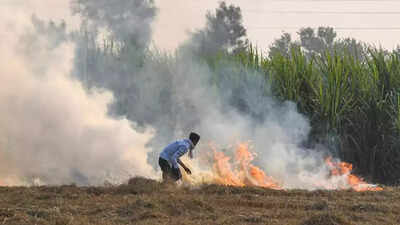Top Searches
- News
- City News
- delhi News
- Delhi: At 3,971, single-day farm fires touch season's peak
Delhi: At 3,971, single-day farm fires touch season's peak
Delhi: At 3,971, single-day farm fires touch season's peak

The highest fire count in a single day this season was 1,826 fires on Saturday (Image used for representational purpose only)
NEW DELHI: At 3,971, the season's highest single-day stubble burning fire count was recorded in neighbouring states on Monday, according to the System of Air Quality and Weather Forecasting And Research (SAFAR), the forecasting body under the Union ministry of earth sciences. Before this, the highest fire count in a single day this season was 1,826 fires on Saturday, SAFAR data shows.
The overall Air Quality Index (AQI) of the national capital was 281 in the 'poor' category on Monday. Though the count of farm fires rose from 1,734 on Sunday to 3,971 on Monday, the impact of stubble burning to Delhi's air was less. The share of stubble burning to Delhi's PM2.5 was just 7% on Monday due to unfavourable wind direction and speed.
The farm fires mostly remained low in October this year as compared with the same month in 2020, but experts said the fire count is likely to witness peak in November. Anumita Roychowdhury, executive director of research and advocacy, Centre for Science and Environment, said, "Due to frequent rains and delayed withdrawal of monsoon, stubble burning, which usually picks up in October, got deferred this year. Farm fires can spike soon as farmers will be in a rush to dispose of the stubble. The agencies concerned should be prepared with an emergency action plan to control fire and smog."
In 2020, the highest number of single-day farm fires was recorded at 4,528 on November 6. Experts said during peak stubble burning window, the fire count is expected to go up to 3,000-4,000 a day.
SAFAR, in its bulletin on Monday, said, "The air quality of Delhi is likely to remain in upper end of poor category for the next two days due to prevailing winds coming from west/south-west direction, reducing transport of emissions from stubble burning. Prevailing shallow mixing layer height reduces dispersion of pollutants."
The overall Air Quality Index (AQI) of the national capital was 281 in the 'poor' category on Monday. Though the count of farm fires rose from 1,734 on Sunday to 3,971 on Monday, the impact of stubble burning to Delhi's air was less. The share of stubble burning to Delhi's PM2.5 was just 7% on Monday due to unfavourable wind direction and speed.
The farm fires mostly remained low in October this year as compared with the same month in 2020, but experts said the fire count is likely to witness peak in November. Anumita Roychowdhury, executive director of research and advocacy, Centre for Science and Environment, said, "Due to frequent rains and delayed withdrawal of monsoon, stubble burning, which usually picks up in October, got deferred this year. Farm fires can spike soon as farmers will be in a rush to dispose of the stubble. The agencies concerned should be prepared with an emergency action plan to control fire and smog."
In 2020, the highest number of single-day farm fires was recorded at 4,528 on November 6. Experts said during peak stubble burning window, the fire count is expected to go up to 3,000-4,000 a day.
SAFAR, in its bulletin on Monday, said, "The air quality of Delhi is likely to remain in upper end of poor category for the next two days due to prevailing winds coming from west/south-west direction, reducing transport of emissions from stubble burning. Prevailing shallow mixing layer height reduces dispersion of pollutants."
FacebookTwitterLinkedinEMail
Start a Conversation
end of article

